
Ipswich Museum
Encyclopedia
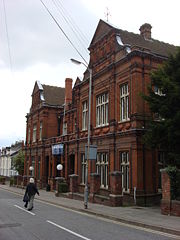
Museum
A museum is an institution that cares for a collection of artifacts and other objects of scientific, artistic, cultural, or historical importance and makes them available for public viewing through exhibits that may be permanent or temporary. Most large museums are located in major cities...
of culture, history and natural heritage located on High Street (off Crown Street) in Ipswich
Ipswich
Ipswich is a large town and a non-metropolitan district. It is the county town of Suffolk, England. Ipswich is located on the estuary of the River Orwell...
, the County Town of the English
England
England is a country that is part of the United Kingdom. It shares land borders with Scotland to the north and Wales to the west; the Irish Sea is to the north west, the Celtic Sea to the south west, with the North Sea to the east and the English Channel to the south separating it from continental...
county of Suffolk
Suffolk
Suffolk is a non-metropolitan county of historic origin in East Anglia, England. It has borders with Norfolk to the north, Cambridgeshire to the west and Essex to the south. The North Sea lies to the east...
. It was historically the leading regional museum in Suffolk, housing collections drawn from both the former counties of East Suffolk and West Suffolk, which were amalgamated in 1974.
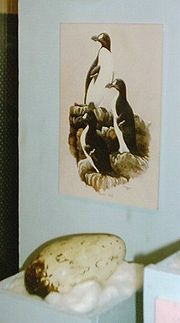
Christchurch Mansion
Christchurch Mansion is a substantial Tudor brick mansion house within Christchurch Park on the edge of the town centre of Ipswich, Suffolk, England...
, a large 16th century house near the town centre in Christchurch Park
Christchurch Park
Christchurch Park is a area of rolling lawns, wooded areas, and delicately created arboreta in central Ipswich, Suffolk, England. It contains Christchurch Mansion which holds a public museum and art gallery. The park opened as the town's first public park in 1895.-History:From the 12th century the...
, was given to the town. It was developed as a second venue under the same management and curatorship, devoted particularly to fine and decorative arts. Both are parts of one institution and draw on the same central core of collections.
Merge with Colchester Museum Service, 2007
On 1 April 2007 the Ipswich Borough Council Museums Service was merged with that of ColchesterColchester
Colchester is an historic town and the largest settlement within the borough of Colchester in Essex, England.At the time of the census in 2001, it had a population of 104,390. However, the population is rapidly increasing, and has been named as one of Britain's fastest growing towns. As the...
Borough Council (Essex
Essex
Essex is a ceremonial and non-metropolitan county in the East region of England, and one of the home counties. It is located to the northeast of Greater London. It borders with Cambridgeshire and Suffolk to the north, Hertfordshire to the west, Kent to the South and London to the south west...
), and its staff transferred to the employment of Colchester. The building and collections, however, remain the property of the town of Ipswich. Ipswich Borough will be responsible for 50% of funding. Since the merger most members of the former Ipswich staff have vacated their posts. Suffolk's largest and oldest Museum, formerly autonomous, is therefore now absorbed into a regional 'hub' under a management centred at Colchester, enabling it to benefit from Designation funding.
Kevin Bentley, portfolio holder for culture at Colchester, is reported to state: 'Colchester is the home of Roman history in Britain
Great Britain
Great Britain or Britain is an island situated to the northwest of Continental Europe. It is the ninth largest island in the world, and the largest European island, as well as the largest of the British Isles...
'.
The early Museum, 1846-1853
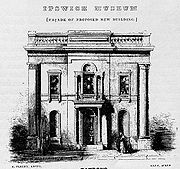
Ipswich
Ipswich is a large town and a non-metropolitan district. It is the county town of Suffolk, England. Ipswich is located on the estuary of the River Orwell...
then newly laid-out, with the specific remit to educate the working classes in natural history
Natural history
Natural history is the scientific research of plants or animals, leaning more towards observational rather than experimental methods of study, and encompasses more research published in magazines than in academic journals. Grouped among the natural sciences, natural history is the systematic study...
. From 1847 to 1853 it was run by a committee on behalf of subscribers, with open evenings for the public. The first President was the entomologist William Kirby (1759-1850), an original Fellow of the Linnean Society, and its founding Patron was Bishop Stanley
Edward Stanley (bishop)
Edward Stanley FRS was a British clergyman and Bishop of Norwich between 1837 and 1849.Born in London into a notable Cheshire family, Stanley was the second son of Sir John Stanley, 6th Baronet, and the younger brother of John Stanley, 1st Baron Stanley of Alderley.Educated at St John's College,...
of Norwich, who presided at the opening.
The primary initiative for this philanthropic venture came from George Ransome, FLS, a member of the Quaker Ransome family of Ipswich. The Ransome
Ransomes, Sims & Jefferies
Ransomes, Sims and Jeffries was a major British agricultural machinery maker producing a wide range of products including traction engines, ploughs, lawn mowers, combine harvesters and other tilling equipment. They also manufactured aeroplanes during the First World War...
engineering industry helped to build the town's industrial prosperity in the early 19th century. All political complexions became involved in the common aim of social improvement through the Museum, and over sixty leading scientists lent their support as Honorary Members or Vice-Presidents.
The Presidency of John Stevens Henslow, 1850-1861
During these first years the museumMuseum
A museum is an institution that cares for a collection of artifacts and other objects of scientific, artistic, cultural, or historical importance and makes them available for public viewing through exhibits that may be permanent or temporary. Most large museums are located in major cities...
gained national repute under its second President (1850-61), Revd Professor John Stevens Henslow
John Stevens Henslow
John Stevens Henslow was an English clergyman, botanist and geologist. He is best remembered as friend and mentor to his pupil Charles Darwin.- Early life :...
, who had been Charles Darwin
Charles Darwin
Charles Robert Darwin FRS was an English naturalist. He established that all species of life have descended over time from common ancestry, and proposed the scientific theory that this branching pattern of evolution resulted from a process that he called natural selection.He published his theory...
's mentor at Cambridge University. In 1851 the British Association for the Advancement of Science
British Association for the Advancement of Science
frame|right|"The BA" logoThe British Association for the Advancement of Science or the British Science Association, formerly known as the BA, is a learned society with the object of promoting science, directing general attention to scientific matters, and facilitating interaction between...
met at Ipswich, and the Museum was inspected and greatly admired by HRH Prince Albert, who became its official Patron.
The natural history displays, including many specimens still on show, were set up in the years preceding the publication of Darwin's book The Origin of Species, to show the relation of the various parts of the natural kingdom as it was then understood, and as it was about to be transformed. Many of the honorary members who actually attended museum functions at Ipswich were people at the centre of that revolution, including William Jackson Hooker
William Jackson Hooker
Sir William Jackson Hooker, FRS was an English systematic botanist and organiser. He held the post of Regius Professor of Botany at Glasgow University, and was the first Director of the Royal Botanic Gardens, Kew. He enjoyed the friendship and support of Sir Joseph Banks for his exploring,...
, William Yarrell
William Yarrell
William Yarrell was an English bookseller and naturalist.Yarrell is best known as the author of The History of British Fishes and The History of British Birds . The latter went into several editions and was the standard reference work for a generation of British ornithologists...
, William Buckland
William Buckland
The Very Rev. Dr William Buckland DD FRS was an English geologist, palaeontologist and Dean of Westminster, who wrote the first full account of a fossil dinosaur, which he named Megalosaurus...
and John Gould
John Gould
John Gould was an English ornithologist and bird artist. The Gould League in Australia was named after him. His identification of the birds now nicknamed "Darwin's finches" played a role in the inception of Darwin's theory of evolution by natural selection...
.
Other honorary members gave important lecture series, notably the first popular course of astronomy
Astronomy
Astronomy is a natural science that deals with the study of celestial objects and phenomena that originate outside the atmosphere of Earth...
lectures by Professor George Biddell Airy
George Biddell Airy
Sir George Biddell Airy PRS KCB was an English mathematician and astronomer, Astronomer Royal from 1835 to 1881...
, lectures on geology by Professors John Stevens Henslow
John Stevens Henslow
John Stevens Henslow was an English clergyman, botanist and geologist. He is best remembered as friend and mentor to his pupil Charles Darwin.- Early life :...
, Adam Sedgwick
Adam Sedgwick
Adam Sedgwick was one of the founders of modern geology. He proposed the Devonian period of the geological timescale...
, Richard Owen
Richard Owen
Sir Richard Owen, FRS KCB was an English biologist, comparative anatomist and palaeontologist.Owen is probably best remembered today for coining the word Dinosauria and for his outspoken opposition to Charles Darwin's theory of evolution by natural selection...
, Edward Forbes
Edward Forbes
Professor Edward Forbes FRS, FGS was a Manx naturalist.-Early years:Forbes was born at Douglas, in the Isle of Man. While still a child, when not engaged in reading, or in the writing of verses and drawing of caricatures, he occupied himself with the collecting of insects, shells, minerals,...
, and Sir Charles Lyell
Charles Lyell
Sir Charles Lyell, 1st Baronet, Kt FRS was a British lawyer and the foremost geologist of his day. He is best known as the author of Principles of Geology, which popularised James Hutton's concepts of uniformitarianism – the idea that the earth was shaped by slow-moving forces still in operation...
, and others by William Carpenter
William Benjamin Carpenter
William Benjamin Carpenter MD CB FRS was an English physician, invertebrate zoologist and physiologist. He was instrumental in the early stages of the unified University of London.-Life:...
, Lyon Playfair, Edwin Lankester
Edwin Lankester
Edwin Lankester MRCS, FRS was an English surgeon and naturalist who made a major contribution to the control of cholera in London: he was the first public analyst in England.- Life :...
, David Ansted
David T. Ansted
David Thomas Ansted was an English geologist and author.- Youth, education :Ansted was born in London on 5 February 1814. He was educated at Jesus College, Cambridge, and after taking his degree of M.A...
, etc.
The Museum adopted by the Corporation, 1853
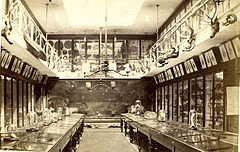
Public Libraries Act 1850
The Public Libraries Act 1850 was an Act of the United Kingdom Parliament which first gave local boroughs the power to establish free public libraries...
. This permitted the levying of a public rate to support such institutions. The collections and properties were formally transferred complete to the Corporation, which retained them in the original premises under the terms of a lease from the builders. Under the new management the terms of public admission were extensively widened. Henslow remained President and continued to develop the collections actively until 1861.
After Henslow's death in 1861, soon after the great confrontation concerning Evolution
Evolution
Evolution is any change across successive generations in the heritable characteristics of biological populations. Evolutionary processes give rise to diversity at every level of biological organisation, including species, individual organisms and molecules such as DNA and proteins.Life on Earth...
between Bishop Samuel Wilberforce
Samuel Wilberforce
Samuel Wilberforce was an English bishop in the Church of England, third son of William Wilberforce. Known as "Soapy Sam", Wilberforce was one of the greatest public speakers of his time and place...
and Thomas Huxley
Thomas Huxley
Thomas Henry Huxley PC FRS was an English biologist, known as "Darwin's Bulldog" for his advocacy of Charles Darwin's theory of evolution....
at Oxford
Oxford
The city of Oxford is the county town of Oxfordshire, England. The city, made prominent by its medieval university, has a population of just under 165,000, with 153,900 living within the district boundary. It lies about 50 miles north-west of London. The rivers Cherwell and Thames run through...
at which Henslow presided, his curator George Knights maintained the collections until his death in 1872.
The Curatorship of Dr John Ellor Taylor FLS, FGS, 1872-1893
George Knights was succeeded by Dr John Ellor TaylorJohn Ellor Taylor
John Ellor Taylor , popular science writer, eldest son of William Taylor , foreman in a Lancashire cotton-factory, and his wife Maria , was born at Levenshulme, near Manchester, on 21 Sept. 1837. He received no education except some desultory instruction at a school held in the Wesleyan chapel,...
(1837-1895), FLS, FGS, botanist and geologist. With the help of Edward Packard, founder of the Packard and Fison fertiliser industry, Taylor created what Sir Ray Lankester
Ray Lankester
Sir E. Ray Lankester KCB, FRS was a British zoologist, born in London.An invertebrate zoologist and evolutionary biologist, he held chairs at University College London and Oxford University. He was the third Director of the Natural History Museum, and was awarded the Copley Medal of the Royal...
considered to be the finest representative collections of local geology in the country. Dr Taylor was also editor of the national popular science journal Hardwicke's Science Gossip Magazine, and leading light of the Ipswich Science Gossip Society (1869), which under his guidance became the Ipswich Scientific Society (1875). He had founded the equivalent Society in Norwich
Norwich
Norwich is a city in England. It is the regional administrative centre and county town of Norfolk. During the 11th century, Norwich was the largest city in England after London, and one of the most important places in the kingdom...
in 1870 and was a co-founder of the Norfolk Geological Society.
Taylor advocated the possibilities of coal-mining in Suffolk
Suffolk
Suffolk is a non-metropolitan county of historic origin in East Anglia, England. It has borders with Norfolk to the north, Cambridgeshire to the west and Essex to the south. The North Sea lies to the east...
, and gave lectures (free to the working classes) to audiences of up to 500, giving 20 lectures each season from 1872–1893. He also made a lecture-tour of Australia
Australia
Australia , officially the Commonwealth of Australia, is a country in the Southern Hemisphere comprising the mainland of the Australian continent, the island of Tasmania, and numerous smaller islands in the Indian and Pacific Oceans. It is the world's sixth-largest country by total area...
in 1885, and wrote several popular books including 'Half-Hours at the Seaside', 'Half-Hours in Green Lanes' and the celebrated title 'The Sagacity and Morality of Plants'. His work contributed very largely to public education in Ipswich.
The New Museum, opened 1881
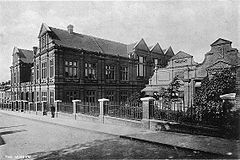
Under Taylor's management the transfer was completed in 1881, and the original 1846 building later became a dance hall. The new museum incorporated a hall with balconies, fitted with the original cabinets and lion case. Further expansion on the site, including an art gallery, new rooms for the schools, and extensive new galleries were completed between 1890 and 1900, and the Borough's floating debt on the project was extinguished by the generosity of Mrs Margaret Ogilvie of Sizewell Hall
Sizewell Hall
Sizewell Hall is a Christian conference centre in Sizewell on the Suffolk coast, England. It is owned by the Ogilvie family. It was for some time the home of a progressive school. It has historic connections with a classic taxidermy collection....
out of appreciation for Taylor's work.
The Curatorship of Frank Woolnough, 1893-1920

Christchurch Mansion
Christchurch Mansion is a substantial Tudor brick mansion house within Christchurch Park on the edge of the town centre of Ipswich, Suffolk, England...
, was given to the town by Felix Cobbold and eventually became the art and local history department of the Borough's Museums. Woolnough made himself a polymath and developed both departments of the museum and also the Schools with great vigour. He was also active in the Museums Association
Museums Association
The Museums Association is a professional organisation based in London for museum professionals and museums in the United Kingdom.The association is the oldest museum association in the world and was started in 1889 by a small group of museums to protect the interests of museums and galleries...
, securing Congress visits in 1908 and 1916, and was local Secretary for the Ipswich Congresses of the British Association for the Advancement of Science of 1895 and of the Royal Archaeological Institute
Royal Archaeological Institute
The Royal Archaeological Institute of Great Britain and Ireland is a learned society, established in 1844, primarily devoted to the publication of the Archaeological Journal, a production of archaeological news that has been in print since 1844....
in 1899.
Prehistoric archaeology owed a special debt to Suffolk since it was at Hoxne
Hoxne
Hoxne is an anciently established village in the Mid Suffolk district of Suffolk, England, about five miles east-southeast of Diss, Norfolk and one-half mile south of the River Waveney...
during the 1790s that John Frere
John Frere
John Frere was an English antiquary and a pioneering discoverer of Old Stone Age or Palaeolithic tools in association with large extinct animals at Hoxne, Suffolk in 1797.-Life:...
recognised humanly-worked flints together with the remains of extinct animals, and the general realisation of the greater antiquity of humankind first began. The Prehistoric Society of East Anglia was created in 1908, centred at Norwich and Ipswich Museums, then the only Society dedicated specifically to this study. Interest developed strongly at Ipswich. The Ipswich investigator James Reid Moir became very active in all the Suffolk county societies and in the Museum, encouraged by his mentor Sir Ray Lankester
Ray Lankester
Sir E. Ray Lankester KCB, FRS was a British zoologist, born in London.An invertebrate zoologist and evolutionary biologist, he held chairs at University College London and Oxford University. He was the third Director of the Natural History Museum, and was awarded the Copley Medal of the Royal...
, who was Museum President 1901-29.
At the same time archaeology
Archaeology
Archaeology, or archeology , is the study of human society, primarily through the recovery and analysis of the material culture and environmental data that they have left behind, which includes artifacts, architecture, biofacts and cultural landscapes...
of various periods (but especially the Prehistoric) in Ipswich and East Anglia was strongly developed by Nina Frances Layard
Nina Frances Layard
Nina Frances Layard was an English poetess, prehistorian, archaeologist and antiquary who made many important discoveries, and by winning the respect of contemporary academics helped to establish a role for women in her field of expertise...
(1853-1935), who in 1920-21 was among the first women admitted as Fellows of the Society of Antiquaries of London
Society of Antiquaries of London
The Society of Antiquaries of London is a learned society "charged by its Royal Charter of 1751 with 'the encouragement, advancement and furtherance of the study and knowledge of the antiquities and history of this and other countries'." It is based at Burlington House, Piccadilly, London , and is...
. She was also the first woman President of the Prehistoric Society, and in the second year of lady Fellows admitted to the Linnean Society (1906). She maintained a long collaboration with Ipswich Museum and bequeathed most of her collections to it.
An important acquisition of this time was the collection of stuffed British birds presented by the Ogilvie family in 1918. Collected in Suffolk and Scotland
Scotland
Scotland is a country that is part of the United Kingdom. Occupying the northern third of the island of Great Britain, it shares a border with England to the south and is bounded by the North Sea to the east, the Atlantic Ocean to the north and west, and the North Channel and Irish Sea to the...
, they represent the long collaboration of F.M. Ogilvie with the Norwich taxidermist Thomas Gunn. This large collection, still intact, on display and in good condition, has extremely beautiful simulated habitats and is now a rare survival. Woolnough also acquired gorillas shot by Paul du Chaillu
Paul du Chaillu
Paul Belloni du Chaillu was a French-American traveler and anthropologist. He became famous in the 1860s as the first modern outsider to confirm the existence of gorillas and the Pygmy people of central Africa. He later researched the prehistory of Scandinavia.-Early life:His date and place of...
, a stuffed giraffe in glass case, and an overstuffed rhino (known variously as 'Gladys' or 'Rosie' by generations of Ipswich schoolchildren), and he completely re-stocked the former lion case with African animals obtained from Messrs Rowland Ward Ltd. Another noted acquisition was a collection of Western Australia
Western Australia
Western Australia is a state of Australia, occupying the entire western third of the Australian continent. It is bounded by the Indian Ocean to the north and west, the Great Australian Bight and Indian Ocean to the south, the Northern Territory to the north-east and South Australia to the south-east...
n aboriginal
Indigenous Australians
Indigenous Australians are the original inhabitants of the Australian continent and nearby islands. The Aboriginal Indigenous Australians migrated from the Indian continent around 75,000 to 100,000 years ago....
material acquired from Emile Clement
Emile Clement
Emile Louis Bruno Clement was a prominent collector of ethnographic artifacts and natural history specimens from northwest Australia at the end of the nineteenth and early twentieth centuries.-Biography:...
.
The Curatorship of Guy Maynard, 1920-1952
Frank Woolnough was succeeded by Guy Maynard (1877-1966), previously of Saffron WaldenSaffron Walden
Saffron Walden is a medium-sized market town in the Uttlesford district of Essex, England. It is located north of Bishop's Stortford, south of Cambridge and approx north of London...
Museum, who was curator from 1920 to 1953. Maynard was Secretary and Editor of the Prehistoric Society from 1921–1936, when this role was taken over by the Cambridge
Cambridge
The city of Cambridge is a university town and the administrative centre of the county of Cambridgeshire, England. It lies in East Anglia about north of London. Cambridge is at the heart of the high-technology centre known as Silicon Fen – a play on Silicon Valley and the fens surrounding the...
archaeologist Charles Phillips
Charles Phillips (archaeologist)
Charles William Phillips was a British archaeologist best known for leading the 1939 excavation of the Sutton Hoo burial ship, an intact collection of Anglo-Saxon grave-goods, possibly that of the 7th century East Anglian king Raedwald.He was the spouse of Margaret Mann Phillips the Erasmus...
. Maynard and Reid Moir made a team interested in archaeology and developed this work strongly on behalf of the museum, excavating in various parts of Suffolk. Museum assistants Harold Spencer and Francis Simpson became specialised in geology and natural history from the 1920s, evolving a departmental structure for the museum through their work and publications with the Suffolk Naturalists' Society and the Ipswich and District Natural History Society. Reports of archaeological work went to the Suffolk Institute of Archaeology
Suffolk Institute of Archaeology
The Suffolk Institute of Archaeology and History is the County Archaeological Society for the County of Suffolk, UK. It was established as the Bury and West Suffolk Institute of Archaeology, at Bury St Edmunds in 1848, but acquired a function for the two counties of West and East Suffolk in 1853...
Proceedings, of which both Reid Moir and Maynard were officers.
Reid Moir succeeded Lankester as President until his death in 1944, and through international contacts developed representative collections of implements from most sites published by the Prehistoric Society. Although some of his theories and researches have since been abandoned he was held in high regard by many of his scientific contemporaries. He was elected a Fellow of the Royal Society
Royal Society
The Royal Society of London for Improving Natural Knowledge, known simply as the Royal Society, is a learned society for science, and is possibly the oldest such society in existence. Founded in November 1660, it was granted a Royal Charter by King Charles II as the "Royal Society of London"...
in 1937.
Guy Maynard continued Woolnough's work in the area of Fine and Applied Art and Local History assiduously. After the Gainsborough
Thomas Gainsborough
Thomas Gainsborough was an English portrait and landscape painter.-Suffolk:Thomas Gainsborough was born in Sudbury, Suffolk. He was the youngest son of John Gainsborough, a weaver and maker of woolen goods. At the age of thirteen he impressed his father with his penciling skills so that he let...
Centenary Exhibition of 1928 a strategy to develop collections showing the Suffolk context of the work of Thomas Gainsborough and John Constable
John Constable
John Constable was an English Romantic painter. Born in Suffolk, he is known principally for his landscape paintings of Dedham Vale, the area surrounding his home—now known as "Constable Country"—which he invested with an intensity of affection...
was carried forward. Active in the Suffolk Preservation Society, Maynard rescued what he could from the disappearing timber structures of Ipswich, modernised the museum records, developed photographic records of Ipswich, maintained annual abstracts of archaeological work in the county, and enormously extended the collections of regional artefacts of all kinds.
After 1934 the Museum's work in practical archaeology became centred on the employment of Basil Brown
Basil Brown
Basil John Wait Brown was a farmer, archaeologist, amateur astronomer and author who most famously discovered the buried ship at Sutton Hoo and excavated its sandy outline on the eve of war in 1939....
(1888-1977), who with Mr Maynard first conducted three years' investigation of a Roman villa
Roman villa
A Roman villa is a villa that was built or lived in during the Roman republic and the Roman Empire. A villa was originally a Roman country house built for the upper class...
at Stanton Chair in Suffolk. The Museum was approached to release Brown for part of 1938 and 1939 to investigate the Sutton Hoo
Sutton Hoo
Sutton Hoo, near to Woodbridge, in the English county of Suffolk, is the site of two 6th and early 7th century cemeteries. One contained an undisturbed ship burial including a wealth of Anglo-Saxon artefacts of outstanding art-historical and archaeological significance, now held in the British...
mounds for Mrs Pretty, under the museum's guidance. In the second year he made the astounding discovery of the ship and its treasure in Mound 1, at which point the national interest of the find led to the formation of an external team led by Charles Phillips.
During the War Guy Maynard had the responsibility of packing up the most valuable collections and transferring them into safe storage, and afterwards of reinstating them. On Reid Moir's death in 1944 he was succeeded as President by Sir Charles Sherrington. Basil Brown was re-employed until the 1960s and continued his work throughout the county, building the basis of the County's Sites and Monuments Record. This was latterly under the curatorship of Norman Smedley (1953-1964), who afterwards formalised the archaeological role for Miss Elizabeth Owles.
Recent Organization
Through a succession of post-War curators (Norman Smedley, Patricia Butler, Alf Hatton, Sara Muldoon and Tim Heyburn) the Museum has passed into a more contemporary pattern of staffing which has varied in number and roles according to perceived priorities and financial restraints of different times. Local Government Reorganization in 1974 merged the two counties of East and West Suffolk. Practical Archaeology then became the function of the new Suffolk County Council Field Archaeology Unit, which also houses the Sites and Monuments Record. The Museum's former link with the Ipswich Art School and the Library Service was also severed as they were transferred to the County Council. The useful honorary office of President has been vacant since the 1970s. The 2007 merger of this historic service with that of Colchester will form the first constitutional change since the public discussion and vote of 1853.Holdings
The Ipswich HoardIpswich Hoard
There are two notable Ipswich Hoards. The first was a hoard of Anglo-Saxon coins discovered in 1863. The second was a hoard of six Iron Age gold torcs that was discovered in 1968 and 1969...
, found near Belstead
Belstead
Belstead is a village and civil parish in the Babergh district of Suffolk, England. Located around south-west of Ipswich town centre, in 2005 it had a population of 190.-Hoard:...
in 1968, is now in the British Museum, but there are also copies of these torcs in this museum.
Sources
- Ipswich Borough Council and Colchester Borough Council, December 2006, 'A Business Plan for a Combined Museum Service for Colchester and Ipswich.'
- RAD Markham, A Rhino in High Street (Ipswich Borough Council 1990).
- SJ Plunkett, The Suffolk Institute of Archaeology: Its Life, Times and Members, Proc Suffolk Inst of Archaeol., 1998.
- New ODNB, entries for Nina Layard, Basil Brown, John Ellor Taylor.
- SJ Plunkett, Dr John Ellor Taylor: Guide, Philosopher and Friend, Proc Suffolk Inst of Archaeol., 2002.
- N Salmon and R Malster (eds), Ipswich From the First to the Third Millennium - Papers from an Ipswich Society Symposium (Ipswich 2001).

